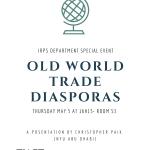Professor Christopher Paik will be presenting on Old World Trade Diasporas (with Lisa Blaydes, Stanford U).
Abstract: What explains worldwide, historical patterns of trade diaspora dispersal? In the premodern period, trade diasporas were among the most important communities facilitating cross-cultural exchange over long distances. We collect data on the locations of trade diaspora communities across Eurasia between 600 and 1600 CE, a time period that predates the rise of European economic, military, and colonial hegemony. Our results suggest two general patterns explaining the proliferation of premodern trade diasporas. First, diaspora merchants were drawn to wealthy societies to obtain access to high-value luxury goods with complex supply chains. Second, traders sought to establish diaspora communities in locations that exhibited bioclimatic complementarities to the merchant’s home region, thereby assisting the procurement of relatively uncommon natural resources. We explore the individual-level mechanisms underlying the patterns we observe through the development of an agent-based model that specifies the agents’ (i.e. traders’) rule-based decisions operating in a wealth and resource-differentiated geographic space that represents premodern Eurasia.




